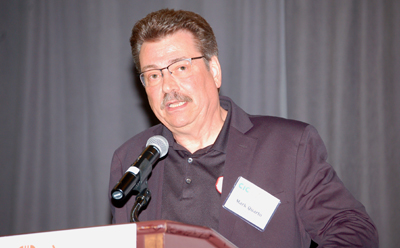Back in 2019, when Jeff Peevy was chairman of the Collision Industry Conference (CIC), he started placing an empty chair on the stage as a reminder to attendees of an important industry constituent not generally represented at the meetings: the consumer.
“Those families who ride in the cars that our industry repairs should be at the forefront of our thoughts,” Peevy said at one CIC meeting that year.
Now the vice president of technical products, programs and services for I-CAR, Peevy said the lack of interest he sees in getting technicians trained to work on electric vehicles (EVs) has him concerned for more than just consumers.
“I see our industry standing on the tracks looking at a freight train coming full speed at us, and we’re just staring at the light,” Peevy said from the floor of CIC this spring. “When we look at the number of those in the industry---regardless of whether it’s repairers or insurers---who have expressed any interest in educating themselves on EVs, it’s shameful, to be honest with you. I think we’re going to need to put another chair up there [on the CIC stage] to represent those who are involved in the repair of electric vehicles, because I’m not sure the technicians and those laying hands on the vehicles have any idea of the danger they are being put in.
"My question is: How many shops are going to turn an EV away when they see it as a job they can do? Yet they may have no idea what they are getting into. I think as an industry we need to search our soul, and become honest about getting educated.”
One MSO's EV Approach
Employee safety was cited as a key reason that even the country’s largest multi-shop operation is taking a conservative approach to gearing up for EV repair. Jeff Brewer, director of EV strategies and OEM certifications for Caliber Collision, said as of this spring, just 21 of the company’s more than 1,700 locations were specifically trained and equipped for EV repair.
“Of those, there’s a few that that’s all they work on,” Brewer said at CIC. “We’re still drinking from the fire hose. We started two years ago and there’s still much we don’t know. It’s really evolving. We have a lot of strategic partners---fleet accounts, insurance accounts or OEM accounts---that would like to see us tool up quicker. We just can’t. We’re taking a very conservative slow approach to it, first and foremost focused on employee safety.”
Space is another consideration, he said. Go to your shop’s back lot, he suggested, and map out the 50 feet of space you’ll need around an EV towed in with significant damage that needs to be quarantined.
“But at the end of the day, it is manageable, it is doable,” Brewer said. “And we don’t really have a choice. I will tell you, when you get to the point---and I imagine a lot of you are already there---that you hang a sign up that says you’re EV-ready, get ready, because you will be swamped. It’s less than 20% of the industry that’s really proactively going after this, creating the solutions.”
He said with past vehicle technologies, the industry had the luxury of a slow roll-out, a tendency to “fake it until you make it.” He pointed to vehicle scanning as an example of a technology the industry was able to adapt to over time. EV repair is not like that, he said.
“This is not a technology that we can slow roll,” he said. “Our company has decided this is not a situation where we can just teach the average collision repair technician another trick.”
Like it or not, he said, EV repair requires a collision repair business “to very quickly be in the mechanical business.” He said this is particularly true for those working with new EV entrant automakers, such as Rivian and Lucid, which require certified body shops to be “full service” in terms of both body and mechanical repair.
“Eighty percent of the industry still doesn’t get that,” Brewer said.
Careful Diagnosis Needed
That need for expansion beyond traditional body and paint work was echoed by another speaker at CIC, Mark Quarto of Quarto Technical Services. Earlier in his career, Quarto spent 28 years with General Motors developing propulsion and battery pack systems. He said particularly with electric vehicles, collision repair businesses will need a thorough intake system that includes looking at more than basic scans and diagnostic trouble codes.
“That data is good, but there are some situations which there won’t be a trouble code but there’s going to be something that’s nearing failure,” Quarto said at CIC. “Sometimes knitting some of the data together helps someone to know how close something is to a failure. So knowing what data to look at, how to look at it, and how to knit some of that together can be helpful. I know in the collision industry, the high voltage electrical stuff especially has not been in the DNA. But it’s going to have to be. You’re going to have to evolve into it.”
Dalan Zartman of the Energy Security Agency said a single thermal image scan of an EV is often insufficient to determine if the battery pack is experiencing thermal runaway. There is often too much between the outer layer of the battery pack enclosure being scanned and the actual battery cells, he said.










John Yoswick